Method 1 – Using the TEXTJOIN Function to Lookup and Extract Multiple Values Joined into Single Cell
In the following dataset, we’ll extract the model names of a specified brand and then concatenate them into a single cell. We want to concatenate all model names of Xiaomi smartphones into one cell.
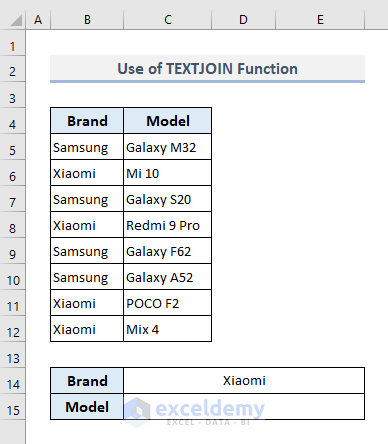
- The required formula in the output cell C15 will be:
=TEXTJOIN(", ", TRUE, IF(C14=B5:B12, C5:C12, ""))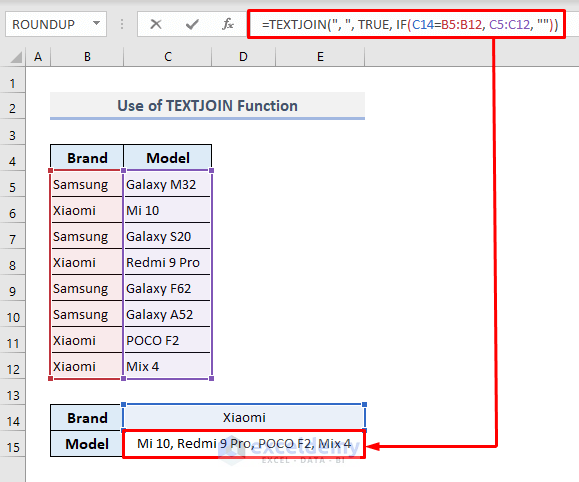
Method 2 – VBA User-Defined Function to Lookup and Return Multiple Values Concatenated into One Cell
Step 1
- Press Alt + F11 to open the VBA window.
- Select the Module option from the Insert tab.
- In the new module window, copy and paste the following code:
Option Explicit
Function CONCATIF(LookupRange As Range, LookupVal As Variant, _
ConcatRange As Range, Optional Separator As String = ",") As Variant
Dim i As Integer
Dim Result As String
On Error Resume Next
If LookupRange.Count <> ConcatRange.Count Then
CONCATIF = CVErr(xlErrRef)
Exit Function
End If
For i = 1 To LookupRange.Count
If LookupRange.Cells(i).Value = LookupVal Then
Result = Result & Separator & ConcatRange.Cells(i).Value
End If
Next i
If Result <> "" Then
Result = VBA.Mid(Result, VBA.Len(Separator) + 1)
End If
CONCATIF = Result
Exit Function
End Function
Sub Lookup_and_Concat()
End Sub- Press F5 to run the code.
- Return to the Excel spreadsheet by pressing Alt + F11 again.
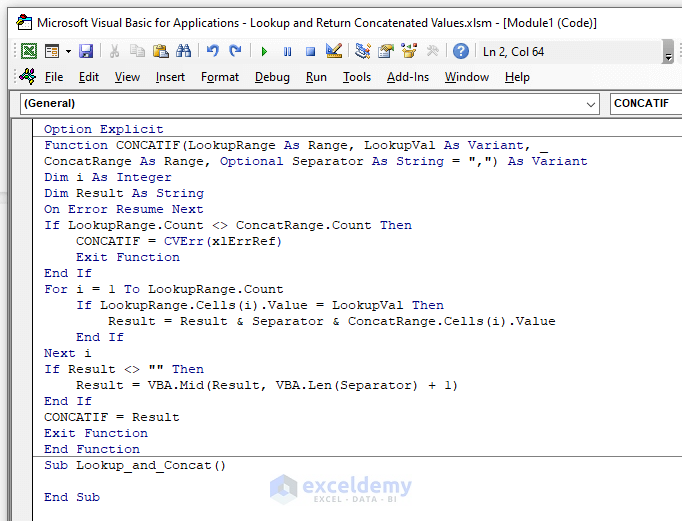
We’ve just created a user-defined function and that is:
=CONCATIF(LookupRange, LookupVal, ConcatRange, [Separator])
Step 2
- Select the output cell C15 and insert:
=CONCATIF(B5:B12,C14,C5:C12,", ")- Press Enter.
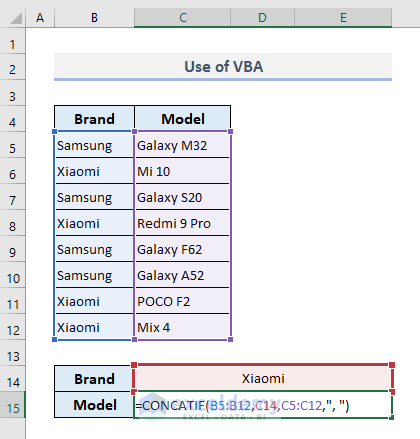
You’ll find the concatenated values in a single cell as shown in the screenshot below.
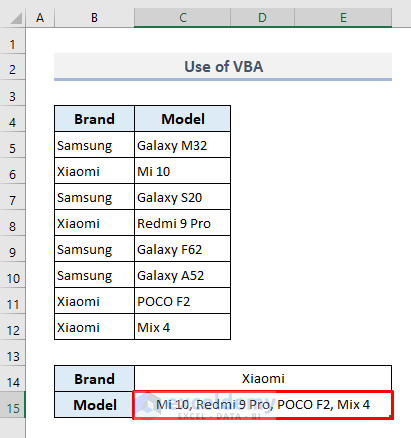
Method 3 – Lookup and Return Multiple Unique Values Concatenated into One Cell
The smartphone model names have duplicates in Column C. We’ll extract and concatenate all smartphone models of a specified brand (in C17) into a single cell but display each model name only once if the duplicates are found.
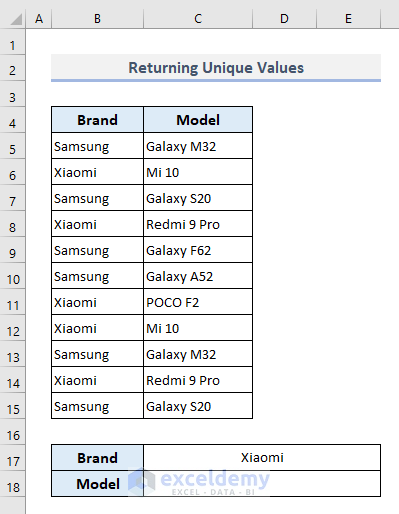
- In the output cell C18, the required formula under the specified criteria will be:
=TEXTJOIN(", ", TRUE, IF(IFERROR(MATCH(C5:C15, IF(C17=B5:B15, C5:C15, ""), 0), "")=MATCH(ROW(B5:B15), ROW(B5:B15)), C5:C15, ""))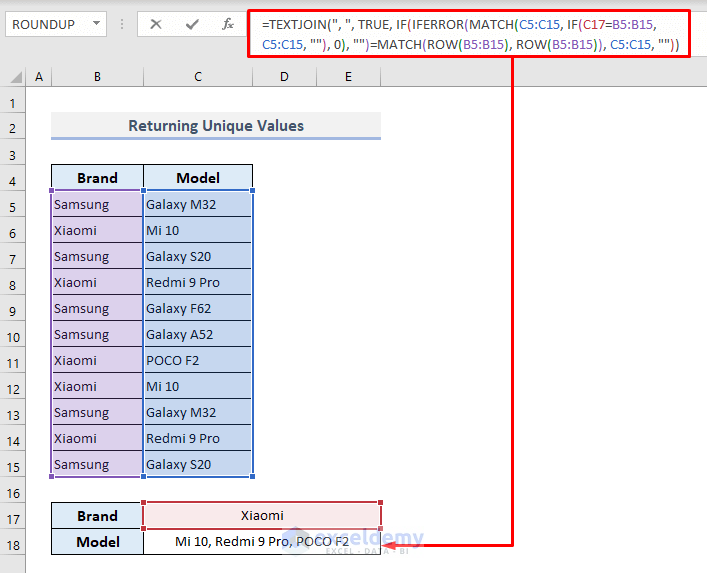
How Does the Formula Work?
- IFERROR(MATCH(C5:C15, IF(C17=B5:B15, C5:C15, “”), 0), “”): This part of the formula checks if the defined condition in cell C17 matches with the values in the range of cells B5:B15 and returns the corresponding row numbers of the values. If duplication is found for a value, then the row number returns for the first value. Thus this part of the formula returns the following array:
{“”;2;””;4;””;””;7;2;””;4;””}
- IF(IFERROR(MATCH(C5:C15, IF(C17=B5:B15, C5:C15, “”), 0), “”)=MATCH(ROW(B5:B15), ROW(B5:B15)), C5:C15, “”): This part is the third argument (text1) of the TEXTJOIN function which defines the statements to be concatenated. The values from Column C will be extracted based on the row numbers found in the previous step. So, the return array here will be:
{“”;”Mi 10″;””;”Redmi 9 Pro”;””;””;”POCO F2″;””;””;””;””}
- The entire formula will concatenate the values obtained in the preceding step with the defined delimiter- Comma (,).
Method 4 – VBA to Lookup and Return Multiple Unique Values Concatenated into One Cell
Step 1
- Press Alt + F11 to open the VBA window.
- Activate a new module from the Insert tab and paste the following code in the new module window:
Option Explicit
Function CONCATUNIQUE(LookupValue As String, LookupTable As Range, Col_Num As Integer)
Dim i As Long
Dim j As Integer
Dim Result As String
For i = 1 To LookupTable.Columns(1).Cells.Count
If LookupTable.Cells(i, 1) = LookupValue Then
For j = 1 To i - 1
If LookupTable.Cells(j, 1) = LookupValue Then
If LookupTable.Cells(j, Col_Num) = LookupTable.Cells(i, Col_Num) Then
GoTo Skip
End If
End If
Next j
Result = Result & " " & LookupTable.Cells(i, Col_Num) & ","
Skip:
End If
Next i
CONCATUNIQUE = Left(Result, Len(Result) - 1)
End Function
Sub Concatenate_Unique()
End Sub- Press F5.
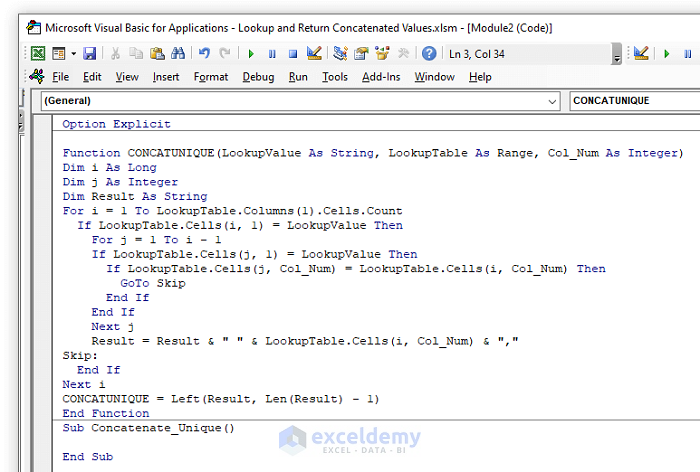
The user-defined function we’ve just created is:
=CONCATUNIQUE(LookupValue, LookupTable, Col_Num)
Step 2
- Return to your Excel spreadsheet by pressing Alt + F11.
- In the output cell C18, put:
=CONCATUNIQUE(C17,B5:C15,2)- Press Enter.
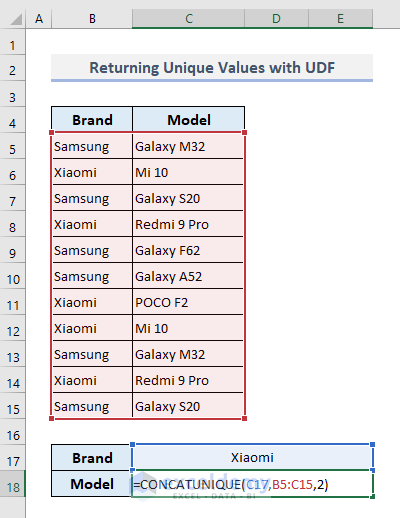
You’ll get the return values in a single cell as shown in the picture below.
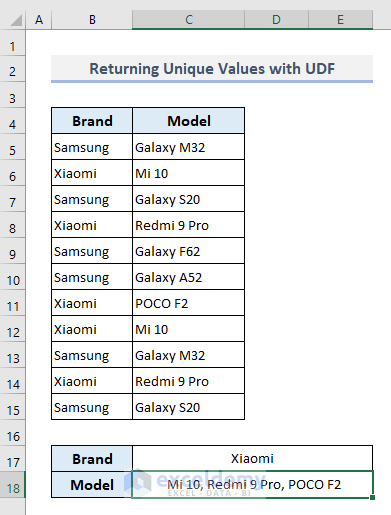
Download the Practice Workbook
<< Go Back to Lookup | Formula List | Learn Excel
Get FREE Advanced Excel Exercises with Solutions!


Thank you for this great collection working.
If it is with out duplication, could we have the occurrence number in front of ever string text, delimiter might : e.g. Brand xiamoi
Model Mi 10:2, Redmi 9 Pro:2, POCO F2:1
Hi Esayas,
You can count that if you mix the formulas with the COUNTIF function. You have to be a bit creative while using it in VBAs. For example, take the first method. You can use =TEXTJOIN(“, “,TRUE,IF(C14=B5:B12,C5:C12&”:”&COUNTIF(C5:C12,IF(B5:B12=C14,C5:C12)),””)) formula instead of the given one to find the count of each one in the dataset along with the models.
Does anyone have a solution to a similar (albeit slightly more complex) scenario where there are potentially multiple entries (several countries as an example) captured within a single cell (but separated by a comma or other delimiter). Each of the entries (country in this example) requires a lookup on a separate table and each of the values returned (for each respective country in the lookup reference) needs to be concatenated into a single cell (preferably in the same order that they appeared within the referenced cell)?
Hope that makes some sense without showing the sample tables.
Dear Adam
Thanks for your feedback. I have reviewed your requirements. It seems like you want to perform a lookup of multiple entries (country names) in a single cell separated by a delimiter, such as commas. There will be a lookup table to keep the corresponding short names for each country. You are looking for a complex formula that takes multiple country names separated by commas, returns corresponding values (country short names), and displays them in a single cell.
Don’t worry! I have demonstrated your situation and developed a complex formula to fulfil your goal. I used the TEXTJOIN, INDEX, MATCH, TRIM, and TEXTSPLIT functions to build the formula.
SOLUTION Overview:
Suppose you want to enter the comma-separated country names in cell E1. In cell E2, you want to display country short names. To do so,
I hope you have found the formula you were looking for. I have attached the solution workbook as well; good luck.
DOWNLOAD SOLUTION WORKBOOK
Regards
Lutfor Rahman Shimanto
ExcelDemy